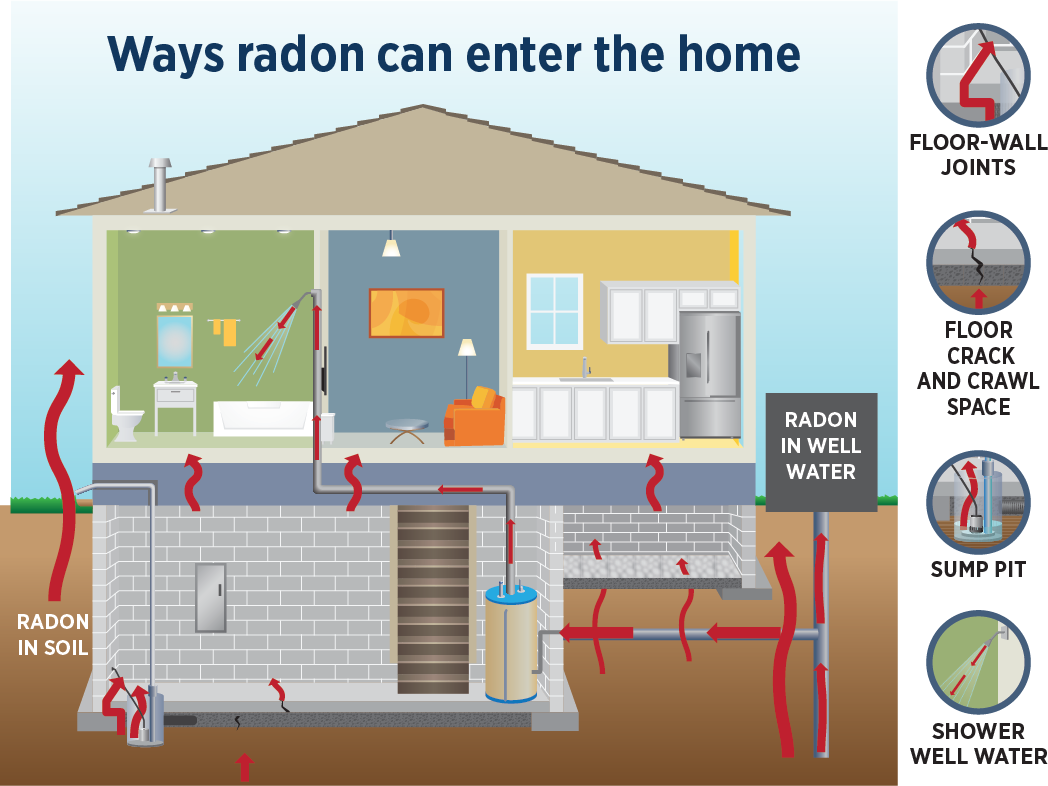If you would like to learn about other indoor air concerns, or if you would like to know more about radon and asthma, contact our office or go to the following link: US Environmental Protection Agency – air
Mold
Molds are simple, microscopic organisms, found virtually everywhere, indoors and outdoors. Molds can be found on plants, foods, dry leaves, and other organic material. Molds are needed for breaking down dead material. Mold spores are very tiny and lightweight, and this allows them to travel through the air. Mold growths can often be seen in the form of discoloration, ranging from white to orange and from green to brown and black. When molds are present in large quantities, they can cause allergic symptoms similar to those caused by plant pollen.
Ten Things You Should Know about Mold
- Potential health effects and symptoms associated with mold exposures include allergic reactions, asthma and other respiratory complaints.
- There is no practical way to eliminate all mold and mold spores in the indoor environment; the way to control indoor mold growth is to control moisture.
- If mold is a problem in your home or school, you must clean up the mold and eliminate sources of moisture.
- Fix the source of the water problem or leak to prevent mold growth.
- Reduce indoor humidity (to 30-60%) to decrease mold growth by:
- Venting bathrooms, dryers and other moisture-generating sources to the outside
- Using air conditioners and de-humidifiers
- Increasing ventilation
- Using exhaust fans whenever cooking, dishwashing and cleaning
- Clean and dry any damp or wet building materials and furnishings within 24-48 hours to prevent mold growth.
- Clean mold off hard surfaces with water and detergent, and dry completely. Absorbent materials such as ceiling tiles, that are moldy, may need to be replaced.
- Prevent condensation: Reduce the potential for condensation on cold surfaces (i.e., windows, piping, exterior walls, roof, or floors) by adding insulation.
- In areas where there is a perpetual moisture problem, do not install carpeting (i.e., by drinking fountains, by classroom sinks, or on concrete floors with leaks or frequent condensation).
- Mold can be found almost anywhere; they can grow on virtually any substance, providing moisture is present. There are molds that can grow on wood, paper, carpet, and foods.
Radon
What is radon?
Radon is a naturally occurring, radioactive gas that results from the natural breakdown of uranium. It can be found almost anywhere in soil,rocks, some building materials and even well water. Radon then escapes into the air we breathe.
How does radon enter a building?
Radon can enter a building from the soil through dirt floors, cracks in concrete floors, floor drains, sump pumps, joints, tiny cracks and pores in hollow-block walls and other openings. Pressure differences between the building and the soil around the foundations can create a slight vacuum that draws the gas from the soil into the building. Once inside an enclosed space, such as a home or office building, radon can accumulate to significant and dangerous levels. The EPA has established an “action level” of *4 pico curies per liter of air (4 pCi/L) or higher, at which point homeowners should take action to reduce the radon risk.

How is radon harmful?
Radon releases decay products, or radioactive particles, which become trapped in our lungs when we breathe. These particles discharge energy that can damage lug tissue. Exposure to radon over time has the potential to cause lung cancer.
How harmful is radon?
Radon is the second leading cause of lung cancer in the United States. The EPA estimates that radon is responsible for 21,000 deaths per year. That’s more than the fatalities caused by drowning, home fires and airline crashes… combined!
How widespread is radon?
The EPA estimates that 1 out of every 15 homes nationwide is at risk of containing dangerously high levels of radon. Iowa is considered to be in a high-risk area and as many as three out of every five homes may be affected. Radon levels can even vary from house to house.
Recommendations:
Test for radon. Each house can have different levels of radon and should be individually tested. (test at least twice if 1st test is high)
Fix home if levels are high -4 pCi/L or more- (list of certified mitigation contractors available from the Iowa Department of Public health 1-800-383-5992) Average cost is $800-2,000. Occasionally lesser radon problems can be fixed using less expensive techniques such as sealing sump pits and other openings in the foundation.
A typical radon mitigation system is a 3″- 4″ PVC pipe extending from a hole in the basement floor through the roof. A permanent fan supplies suction through the pipe drawing radon from beneath the slab and exhausting it outside above the eaves level of the house.
Iowa law requires professionals who install radon mitigation systems to be certified by the Iowa Department of Public Health. (List available at 1-800-383-5992) Knowledgeable homeowners may take corrective action to reduce radon levels in their own homes (U.S. Environmental Protection Agency pamphlets are available).
Note: A single short-term test should not be used as a basis to mitigate your home, radon levels may fluctuate over the short term time period. The average of at least 2 short-term radon tests, or one long-term test, or a professional continuous monitor test should be used to determine if the house needs to be fixed or not.
Places to Purchase Test Kits:
- American Lung Association
1-800-383-5992
http://www.healthhouse.org/radon/testkit.cfm - Linn County Public Health
(319) 892-6000
https://www.lchh.org/radon/order-radon-test-kits - Air Chek
1-800-AIR-CHEK / 1-800-247-2435
https://www.radon.com/radon_airchek/ - Alpha Energy Laboratories
(800) 324-5928
https://www.doctorhomeair.com/radoninfo/
*Long and short term kits available at all agencies*
Questions about radon kits: Iowa AIR Coalition — 1-800-206-7818 or (319)-892-6054
Asthma
Asthma is a condition that keeps you from breathing normally. When you have an asthma attack, your airways get narrow, making it difficult to breathe. Some of the symptoms are coughing, wheezing, and shortness of breath. Indoor pollutants that include secondhand smoke, dust, dust mites, pets, molds, and pests can trigger asthma. Many outdoor triggers exist also.
Carbon Monoxide
CO is odorless, colorless, and otherwise undetectable to the human senses, people may not know that they are being exposed. The initial symptoms of low to moderate CO poisoning are similar to the flu (but without the fever).
Carbon Monoxide Safety Tips
- Have your home heating systems (including chimneys and vents) inspected and serviced annually by a trained service technician.
- Never use portable generators inside homes or garages, even if doors and windows are open. Use generators outside only, far away from the home.
- Never bring a charcoal grill into the house for heating or cooking. Do not barbeque in the garage.
- Never use a gas range or oven for heating.
- Open the fireplace damper before lighting a fire and keep it open until the ashes are cool. An open damper may help prevent buildup of poisonous gases inside the home.
- Install battery-operated CO alarms or CO alarms with battery backup in your home outside separate sleeping areas.
- Know the symptoms of carbon monoxide poisoning: headache, dizziness, weakness, nausea, vomiting, sleepiness, and confusion. If you suspect CO poisoning, get outside to fresh air immediately, and then call 911.
Symptoms of CO Poisoning:
- Headache
- Fatigue
- Shortness of breath
- Nausea
- Dizziness
High level CO poisoning results in progressively more severe symptoms, including:
- Mental confusion
- Vomiting
- Loss of muscular coordination
- Loss of consciousness
- Ultimately death
Symptom severity is related to both the CO level and the duration of exposure. For slowly developing residential CO problems, occupants and/or physicians can mistake mild to moderate CO poisoning symptoms for the flu, which sometimes results in tragic deaths. For rapidly developing, high level CO exposures (e.g., associated with use of generators in residential spaces), victims can rapidly become mentally confused, and can lose muscle control without having first experienced milder symptoms; they will likely die if not rescued.

